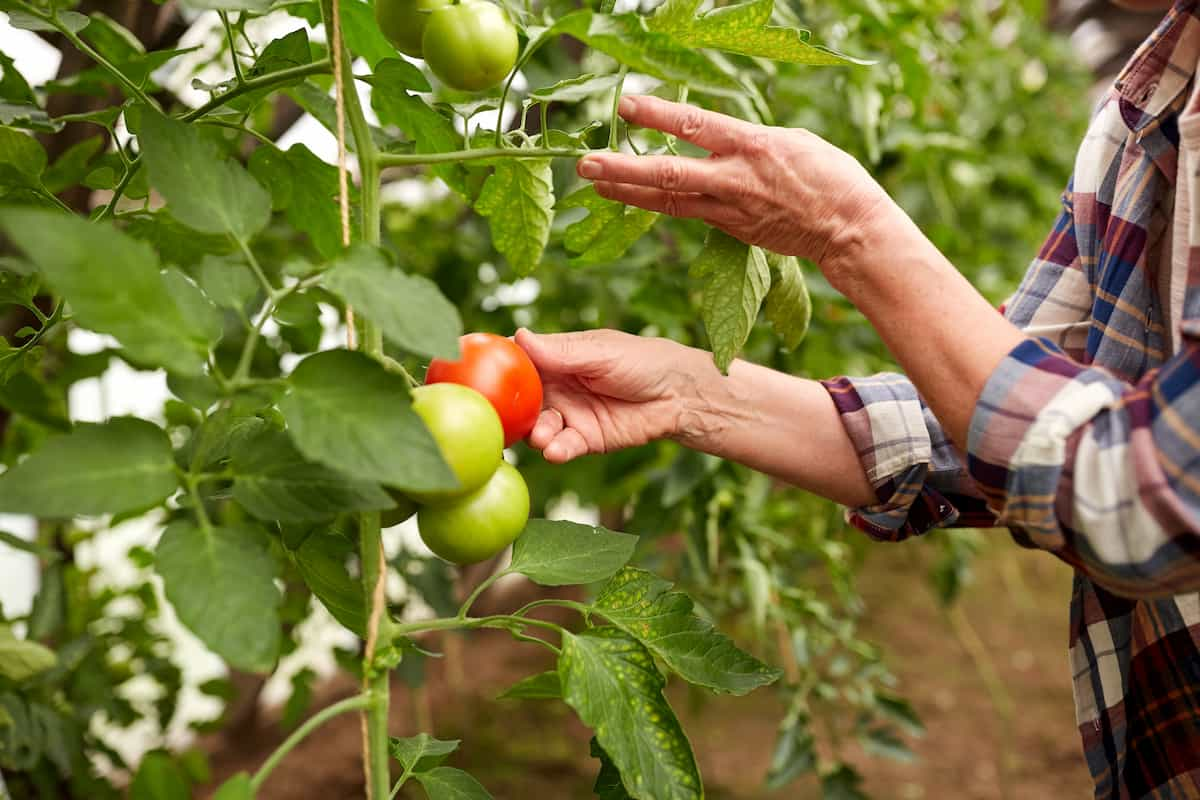The tomato fruitworm (Helicoverpa zea) is a destructive pest that affects various crops, including tomatoes, cotton, and corn. It is a moth species with distinctive physical characteristics such as a pale tan to medium brown color with marked front wings and a hind wing with a dark gray band. The larvae of this species start as creamy white caterpillars with blackheads, tubercles, and hairs.

They can vary in color as they grow, developing fine white lines and stubby spines on their body segments. The eggs of the tomato fruitworm are easily recognizable due to their spherical shape, coarse striations, and reddish-brown ring that develops 24 hours after being laid. Identifying and controlling this pest is important to protect crops from damage.
Fruitworm management in Tomato
The life cycle of Tomato Fruitworm
- Egg stage: Tomato fruitworm moths lay eggs individually on leaf tissue and corn silks. The eggs hatch in 3-4 days.
- Larval stage: After hatching, larvae feed on foliage and fruiting structures, with older larvae becoming cannibalistic. The larvae develop through 5-6 instars throughout 14 to 21 days.
- Pupal stage: Once fully grown, larvae fall into the ground and burrow in the soil to pupate. This stage lasts about 13 days in the summer and serves as the overwintering stage in the late fall.
- Adult stage: After pupation, adults emerge from the ground, mate, and lay eggs to start the cycle over again.
Identification of Tomato Fruitworm in Tomato field
- Tomato fruitworm larvae are creamy white caterpillars with blackheads and prominent black tubercles and hairs when they hatch.
- Larger larvae range from yellowish green to nearly black, with fine white lines running down the body but black spots at the base of bristlelike hairs remaining.
- Older larvae have patches of stubby spines on their body segments, which are much shorter than the bristles and are best seen with a hand lens.
- The tops of the tiny, spherical eggs are flattened, with coarse striations or ribs running from base to tip. They are easily confused with looper eggs, but their striations are finer.
Damage symptoms of Tomato Fruitworm in Tomato field
- The larvae cause the damage symptoms of tomato fruit worms in tomato fields.
- The larvae have chewing mouthparts and remove plant tissue, causing holes and gouges in the leaves and fruit.
- They prefer to feed on reproductive structures, such as Tomato and pepper fruit, but can also damage leaf tissue.
- A single larva can damage multiple fruits. Early instar larvae can attack fruit without any leaf feeding, causing significant damage to the crop.
In case you missed it: Tobacco Cutworm Management in Cotton: Symptoms, Treatment, Chemical, Biological, Natural, and Organic Control

Cultural control of Tomato Fruitworm
Cultural controls are practices aimed at reducing the population of tomato fruit worms and limiting their damage to crops. Some of the cultural control measures include:
- Starting with a clean field by avoiding planting Tomato and pepper fields near post-silking corn fields
- Sanitation practices such as disposing of culled fruit from infested fields as far away from production fields as possible
- Manipulating the field by destroying abandoned fields immediately after final harvest by deep disking to disrupt pupating larvae and infested fruit
- Destroying volunteer plants and weed hosts during the off-season by frequent disking.
Biological control of Tomato Fruitworm
- Biological control uses natural enemies such as parasites, predators, and pathogens to manage pests.
- In the case of tomato fruit worms, Trichogramma pretiosum and Hyposoter exiguae are used as biological controls.
- Trichogramma parasitizes the eggs of the fruit worm, while Hyposoter attacks the larvae. Releases of Trichogramma and the presence of Hyposoter can help to reduce fruit worm populations and provide an alternative to chemical controls.
Chemical control of Tomato Fruitworm
- Chemical control of tomato fruitworm can be achieved by applying weekly sprays containing insecticides such as spinosad or pyrethroids (permethrin, cyfluthrin, bifenthrin) once the tomatoes begin to bloom and set fruit.
- These insecticides are effective in controlling fruit worms. In the case of pyrethroids, they can also control other pests like stink bugs and leaf-footed bugs.
In case you missed it: Pink Bollworm Management in Cotton: Symptoms, Treatment, Chemical, Biological, Natural, and Organic Control

Organic/natural control of Tomato Fruitworm
- The tomato fruitworm has natural enemies, including the parasitic wasp Trichogramma pretiosum, which attacks the eggs and can result in 40-80% parasitism.
- Other predators include lacewings, big-eyed bugs, damsel bugs, and minute pirate bugs, which attack young larvae. The most important species of parasitic wasps observed attacking larvae include Cotesia spp., Microplitis croceipes, and Hyposoter exiguae.
- The biological control of tomato fruitworm can be enhanced by avoiding broad-spectrum insecticides, reducing the number of insecticide applications, and using reduced-risk insecticides.
Preventive measures for control of Tomato Fruitworm
- Avoid planting corn near tomatoes as it is one of the significant fruit worm hosts.
- Monitor Tomato plants for eggs and handpick leaves where eggs are laid.
- Eliminate eggs to reduce the population dramatically by removing them from the leaves.
- Prevent larvae from entering fruit by covering the plants with fine netting.
- Encourage natural predators by planting dill, parsley, asters, goldenrod, daisies, alfalfa, and stinging nettle.
- Parasitic wasps can also be purchased and released into the garden to help control fruit worms.
- Remove affected plants at the end of the season.
- Till soil after harvest, in late winter, and early spring to destroy pupae.
Conclusion
In conclusion, tomato fruitworm (Helicoverpa zea) is a severe pest that can cause significant damage to tomato crops. Understanding the symptoms of infestation, such as holes in fruit, wilted leaves, and silken webs, is crucial for time management. Chemical, biological, natural, and organic control methods offer pest management options.
Still, it is important to consider the impact on the environment and human health before choosing a control method. Using integrated pest management techniques that include a combination of crop rotation, resistant varieties, and proper cultural practices can be the most effective way to manage tomato fruit worms. With proper management, tomato farmers can reduce the damage caused by this pest and maintain a healthy, productive crop.
- Types of Fungicides Used in Agriculture
- Common Issues in the Fruit Development Stage of Pomegranate Farming
- Fruit Development Issues in Papaya: Easy Solutions and Treatment
- Soil-Borne Diseases and How to Protect Your Plants
- Practices to Prevent Disease Spread in the Garden
- From Wilted to Thriving: How to Treat Root Rot Naturally in Houseplants
- Natural Remedies to Cure Brown Spots on Fig Tree Leaves
- Natural Solutions for Poinsettia Problems: 100% Effective Remedies
- How to Control Calla Lily Problems: Natural Remedies for Leaf and Flower Problems